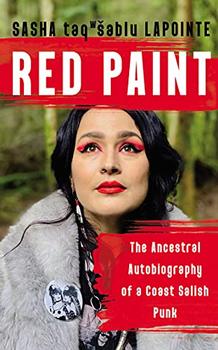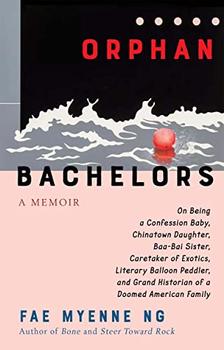Summary | Excerpt | Reviews | Beyond the book | Read-Alikes | Genres & Themes | Author Bio

The Ancestral Autobiography of a Coast Salish Punk
by Sasha taqʷšəblu LaPointeIn Red Paint: The Ancestral Autobiography of a Coast Salish Punk, Sasha LaPointe doesn't weave together multiple subjects and events so much as skillfully capture their intersection. A central topic of the book is her reckoning with trauma from sexual assaults she experienced as a child and a teenager, and her Coast Salish heritage (from the Nooksack and Upper Skagit Indian tribes) is not just instrumental to her journey to recovery but intrinsic to it. Likewise, the Pacific Northwest is intrinsic to her ancestral exploration; her love for music is central to her search, as a mixed heritage Indigenous woman with nomadic ancestors, for a place to call home; and her understanding of place is informed by art and pop culture. Red Paint is about trauma and healing. It is also about punk rock, the author's own music (see Beyond the Book), David Lynch's surreal television series Twin Peaks and the likewise surreal experience of existing as an Indigenous person in a colonized land.
LaPointe recounts early in the book that when she met Brandon, the man who would become her husband (then ex-husband), she was attracted to him because he resembled the handsome FBI agent Dale Cooper from Twin Peaks. She goes on to explain her love for the show, where she recognized her own rainy corner of Washington and appreciated the inclusion of the Native American character Deputy Hawk despite his stereotypical presentation. She identified with Audrey Horne, a restless, savvy teenager who falls for Cooper and believes that he can save her from her troubled small-town existence. By showing the reader this connection between the series and her own life, LaPointe foreshadows the futility of her attempts to find a sense of home in Brandon that she is missing elsewhere, and also draws attention to the power of art and invention: Lynch's fiction and his character's fantasies have served as fuel for her own fantasies, which eventually affect her in a real, material way. In Red Paint, she invokes the equally real power to create a new and necessary narrative while interacting with artistic and cultural traditions.
LaPointe's marriage to Brandon lends her story its movement, as it represents an attempt to establish a place for herself in the world and serves as the catalyst for her first forays into creative nonfiction, which cause her to reencounter the trauma she suffered in her youth. It also represents a testing of her own needs and limits, as she craves security, but at the time of her engagement views herself as independent and non-traditional — she is living in a different state than her fiancé part of the time and is also dating a woman with his knowledge. Her quest to understand herself makes her frequent jumps in time feel natural, as exploration of her trauma leads her to connect with people from her personal and ancestral history. Her rekindled friendship with an ex-boyfriend, Richard, threatens her soon shaky relationship with Brandon, and as she finds herself overwhelmed with the physical and mental manifestations of old pain and fresh losses, she feels the need to reach deeper into Coast Salish spiritual traditions and her family's past. She continually returns to the story of Comptia Koholowish, an ancestor who married a Scottish sailor after her entire village died of smallpox. LaPointe wonders about Comptia's strength and motivations, and looks to her for guidance.
Through a nomadic and place-sensitive gaze on the Pacific Northwest, LaPointe presents a separation between land and state that throws into sharp relief the strangeness of settler-colonial fictions and values. When she seeks out the area where her ancestor lived, she finds misinformation in a historical pamphlet that suggests Comptia drowned at sea simply because her husband did:
She was not even allowed her own death. … An heir had asked for the property to be condemned. Why shouldn't it be? I wondered. Tear it down and in its place erect a carving of Comptia.
The subjects LaPointe combines do not fit together simply because she blends them well (although she does) but rather because, as she shows us, trauma does not exist in a vacuum — or in any one place. Neither, necessarily, does the concept of home. Through the fluidity of her writing, LaPointe honors the movement and exploration crucial for healing. Red Paint is an important act of documentation and creation, a viewing that is also a doing.
![]() This review was originally published in The BookBrowse Review in April 2022, and has been updated for the
March 2023 edition.
Click here to go to this issue.
This review was originally published in The BookBrowse Review in April 2022, and has been updated for the
March 2023 edition.
Click here to go to this issue.

If you liked Red Paint, try these:

by Caro De Robertis
Published 2025
Award-winning novelist Caro De Robertis offers a first-of-its-kind, deeply personal, and moving oral history of a generation of queer and trans elders of color, from leading activists to artists to ordinary citizens to tell their stories of breathtaking courage, cultural innovations, and acts of resistance, all in their own words.

by Fae Myenne Ng
Published 2024
From the bestselling and award-winning author of novels Bone and Steer Toward Rock, Fae Myenne Ng's Orphan Bachelors is an extraordinary memoir of her beloved San Francisco's Chinatown and of a family building a life in a country bent on their exclusion
Your guide toexceptional books
BookBrowse seeks out and recommends the best in contemporary fiction and nonfiction—books that not only engage and entertain but also deepen our understanding of ourselves and the world around us.